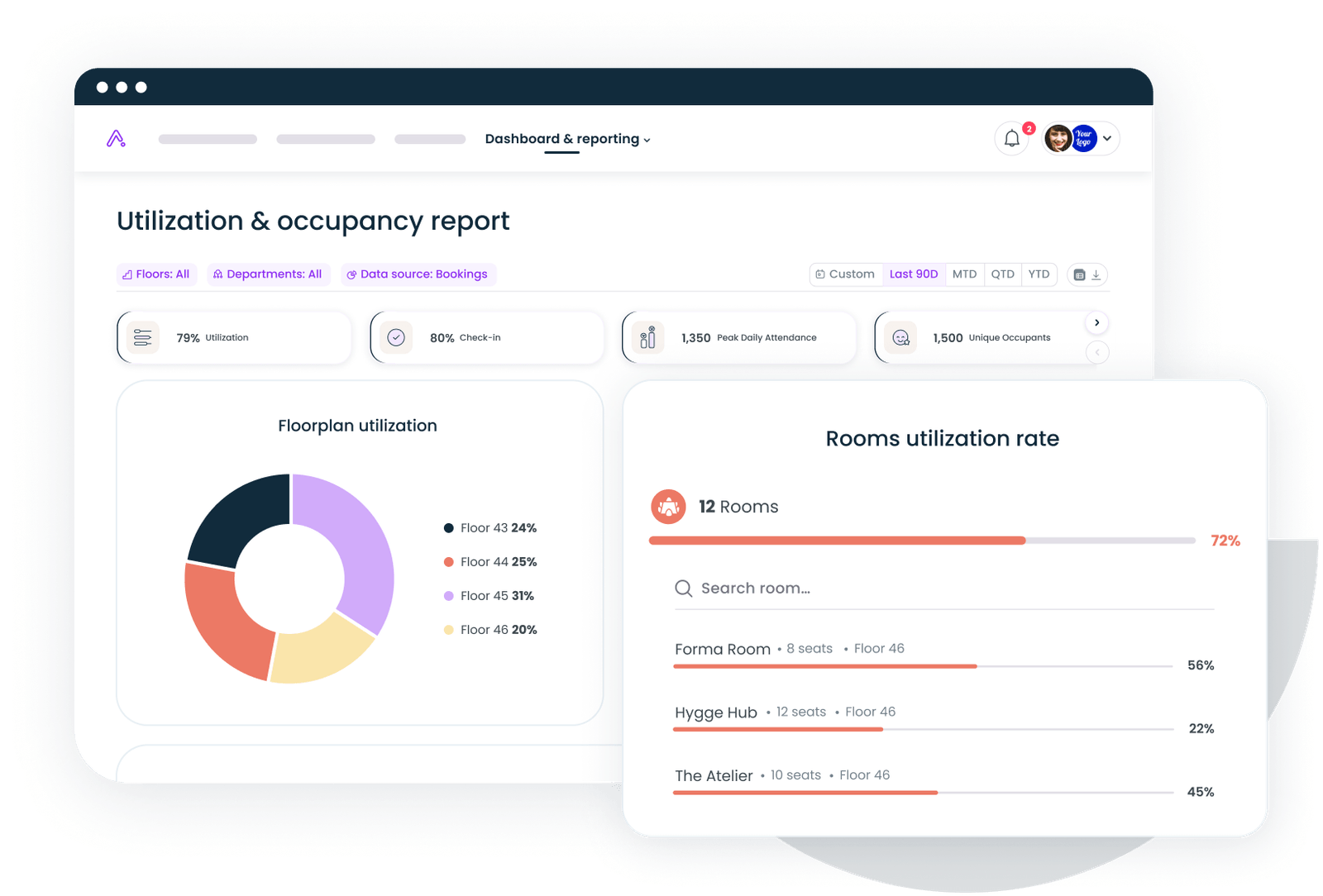Activity-based working transforms how modern workplaces operate by enabling employees to choose from different spaces designed for specific tasks throughout their workday. Rather than spending eight hours at assigned desks, workers move between physical spaces optimized for collaboration, focused work, meetings, and social interaction.
The activity-based work model recognizes that employees perform different tasks daily and need different workplace environments to improve productivity and well-being.
Initially developed by Dutch consultant Erik Veldhoen in the 1990s and first implemented at Interpolis, a Dutch insurance company, activity-based workspace design has evolved into a mainstream workplace strategy that addresses the needs of hybrid work and distributed teams.
What is activity-based working?
Activity-based working is a workplace strategy that provides multiple work settings within the office workspace, allowing employees to select the most appropriate space for their current activity. Unlike traditional offices with fixed workstations where employees remain stationary regardless of their tasks, the activity-based office offers diverse options matched to specific tasks.
An employee might start their morning in a quiet space for concentrated analysis, move to an open lounge for a brainstorming session, take a video call from a phone booth, and collaborate in a project room with their team.
The key distinction lies in intentionality: activity-based working integrates physical workplace design, technology infrastructure, and workplace culture to enable employees to work efficiently based on the work they're performing.
Four elements of activity-based working
Successful implementation of activity-based workplace strategies requires four essential elements working together.
Diverse space types
The foundation of any activity-based workplace is variety. Quiet nooks provide distraction-free zones for focused work with sound-dampening materials and individual work settings. Collaborative areas facilitate group work through open lounges, project rooms, and shared desk spaces equipped with writable surfaces and movable furniture.
Private spaces like phone booths and conference rooms ensure individual employees can handle confidential matters without disrupting others. Social zones support informal interactions and relationship building. Research shows companies with diverse work settings see measurable improvements in collaboration and employee satisfaction.
Technology enablement
The success of activity-based working models depends on technology that supports mobility. Cloud-based systems allow employees to access work from any location, while wireless connectivity ensures seamless transitions between work settings.
Space booking software manages shared desks and meeting rooms, enabling office workers to reserve them in advance. Workplace analytics tools track office space utilization patterns, helping facility managers optimize the office environment based on actual behavior.
Behavioral guidance
Physical design alone doesn't create successful activity-based workspaces: clear behavioral norms are essential. Visual and sensory cues help reinforce appropriate behaviors. Quiet zones feature softer lighting and sound-absorbing materials that signal silence, while collaborative areas use bright colors and open layouts that encourage interaction. Organizations must establish clean-desk policies ensuring each workspace remains ready for the next user.

Discover how workplace leaders are using data-driven insights to optimize space utilization and improve employee experience in hybrid office environments.
Read more
Continuous refinement
Activity-based working requires ongoing iteration based on employee feedback and utilization data. Regular surveys capture employee experiences and identify pain points, while space utilization analytics reveal usage patterns. This data drives improvements—whether adding more phone booths based on demand or converting underused areas into collaborative spaces.
Benefits of activity-based working
Research demonstrates that properly implemented activity-based working delivers significant advantages for both organizations and individual employees.
Enhanced employee satisfaction and well-being
Studies show employee satisfaction increases an average of 17% after companies transition to activity-based working environments. The flexibility supports varied work styles and preferences, acknowledging that different tasks require different conditions. Employee engagement remains critical to organizational success, with engaged employees producing substantially better business outcomes.
Increased productivity and focused work
When employees choose work settings matched to specific tasks, team productivity improves. Deep analytical work takes place in dedicated spaces designed for concentration, while collaborative projects benefit from areas that facilitate group work. The ability to shift between different spaces helps employees manage energy levels effectively, supporting both well-being and work-life balance.
Improved collaboration and innovation
Activity-based workplaces naturally encourage more frequent interactions between team members and across departments. Without dedicated workstations, multiple employees from different teams often work together in collaborative areas, creating opportunities for knowledge sharing. Organizations implementing thoughtful collaborative office layouts report enhanced collaboration and stronger team dynamics.
Optimized real estate costs
Activity-based working enables more efficient space utilization, reducing square footage requirements compared to traditional offices. Most offices average around 40% utilization in traditional workplaces.
The shared nature of workspaces means organizations need fewer total stations. If data shows only 60-70% of employees come to the office on any given day, significant space optimization becomes possible, with savings reinvested in higher-quality furnishings or better technology.
Support for hybrid working models
Activity-based workplace strategies naturally complement hybrid work arrangements. The office becomes a destination for workplace activities that benefit from in-person presence: complex collaboration, relationship building, access to specialized resources—rather than a default location for all work. This flexibility attracts and retains talent seeking more autonomy. Organizations embracing flexible workspace solutions position themselves competitively in the talent market.
Implementing activity-based working
Successfully transitioning to an activity-based workplace requires thoughtful planning, clear communication, and ongoing management.
Assess your organization's needs
Conduct surveys and interviews to identify the types of activities employees perform daily and work settings that would best support those tasks. Track current space utilization to establish baseline metrics. Different departments have varying needs—engineering teams might require more quiet areas for focused work, while sales teams prioritize collaborative areas and private spaces for client calls.
Design diverse work settings
Create a portfolio of dynamic environments supporting your team's workday activities. Balance is critical: too many open spaces without enough quiet rooms leaves employees frustrated—separate collaborative areas from quiet zones to prevent noise from disrupting focused work. Use sound-dampening materials and strategic layouts to manage sound transmission. Invest in quality furniture, such as height-adjustable desks and movable furniture, that allow teams to reconfigure spaces based on specific tasks.
Gable Offices provides intuitive desk booking, room reservations, and real-time availability, so employees can easily find the right space, and office managers gain visibility into utilization patterns.
Explore Gable Offices
Implement enabling technology
Space scheduling software forms the backbone of activity-based working. Employees need tools to see what's available, reserve spaces, and coordinate with colleagues. The best platforms integrate with existing calendar systems and provide mobile access. Deploy occupancy sensors and analytics tools to gather data on how different spaces are used, revealing whether design assumptions match actual behavior.
Build the right culture
Leadership must model desired behaviors by using them in various work settings. Communicate expectations and guidelines clearly for each space type. Provide training on the booking system and protocols for keeping shared desk spaces clean. Address concerns transparently: some employees may feel anxious about losing assigned desks. Establish personal storage solutions, such as lockers or mobile pedestals, so employees maintain a sense of ownership.
Measure and iterate
Establish key metrics to track success, including space utilization rates, employee satisfaction scores, collaboration frequency, and real estate costs. Review this data quarterly and make evidence-based adjustments. Organizations that take a data-driven approach to workplace management achieve better outcomes than those that rely on assumptions.
Activity-based working delivers results when implemented with the right tools and a flexible approach. See how Gable helps companies create flexible, productive work environments that adapt to evolving needs.
Get a demo





.svg)





.svg)
















.svg)













